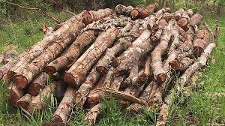Local Charcoal Production in Liberia
- Ezekiel Mavolo, Field Supervisor and FGP
- Sep 27, 2020
- 2 min read
Local Charcoal production in Liberia involves several hard laborers, felling down trees, cutting them into pieces, packing the pieces together, setting them ablaze, and picking the coal. Despite the arduous nature of the job, it serves as a source of income for many people. On the other hand, it has many harmful effects that are unrecognized.
Firstly, there are two popular means charcoal producers in Liberia use to fell trees; power saw and ax, with the most widely used being the ax. Felling a tree involves a skill that enables individuals to fell medium and large sizes of trees within a short period. Therefore, laborers have developed a skill for knowing which branches and sides of the trees to chop first, which saves them energy and allows for the tree to fall with minimal effort. They also must look out for the size and type of each tree to ensure the tree can be cross-cut effectively and that it will produce adequate coal when burned. These selection aspects of cutting down trees are crucial to the production cycle.
Secondly, charcoal producers search for the best suitable area to pack the cross-cut pieces together. However, in searching for a suitable place, they look for materials such as raw leaves and dirt. These two materials are used after they have adequately packed the pieces together. They used the raw leaves first to cover the entire coal bay except for its peak. The purpose of this is to prevent the dirt from direct contact of the bay. Now, if the dirt comes in direct contact with the coal bay, the charcoal producer will be unable to set fire to it. However, after the covering with raw leaves, they gradually begin to use the dirt to cover all the raw leaves until no leaves can be seen.
Thirdly, after the covering, charcoal producers set fire to the coal bay's top. To start it, they gather dry materials such as small pieces of wood kindling and dry leaves or palm straws. They use these materials to blaze a large fire on top of the bay, which gradually extends to the rest of the pile. After properly ablaze, the producer stays by to watch over the bay for over a week, continuing to pack kindling, leaves and dirt on top to keep the coal bay covered as it burns and to prevent air channels from bursting through.
Fourthly, immediately after the burning stage is complete, they use a rake to quickly clear the dirt, and extinguish the finished coals with water. Once cooled, they can begin to pick the coal into bags, using rain-boots and gloves to protect themselves.
To conclude, even though charcoal production involves hard labor and serves as a source of income for some people, it also has side effects that contribute to global warming. These negative side effects can be taken care of by planting at least two trees in place of each one we cut down, something everyday gandhis has begun doing in several communities across the region. We have the absolute power to contribute to curbing global warming by re-planting the trees we destroy and producing in balance with the natural world.

































Comments